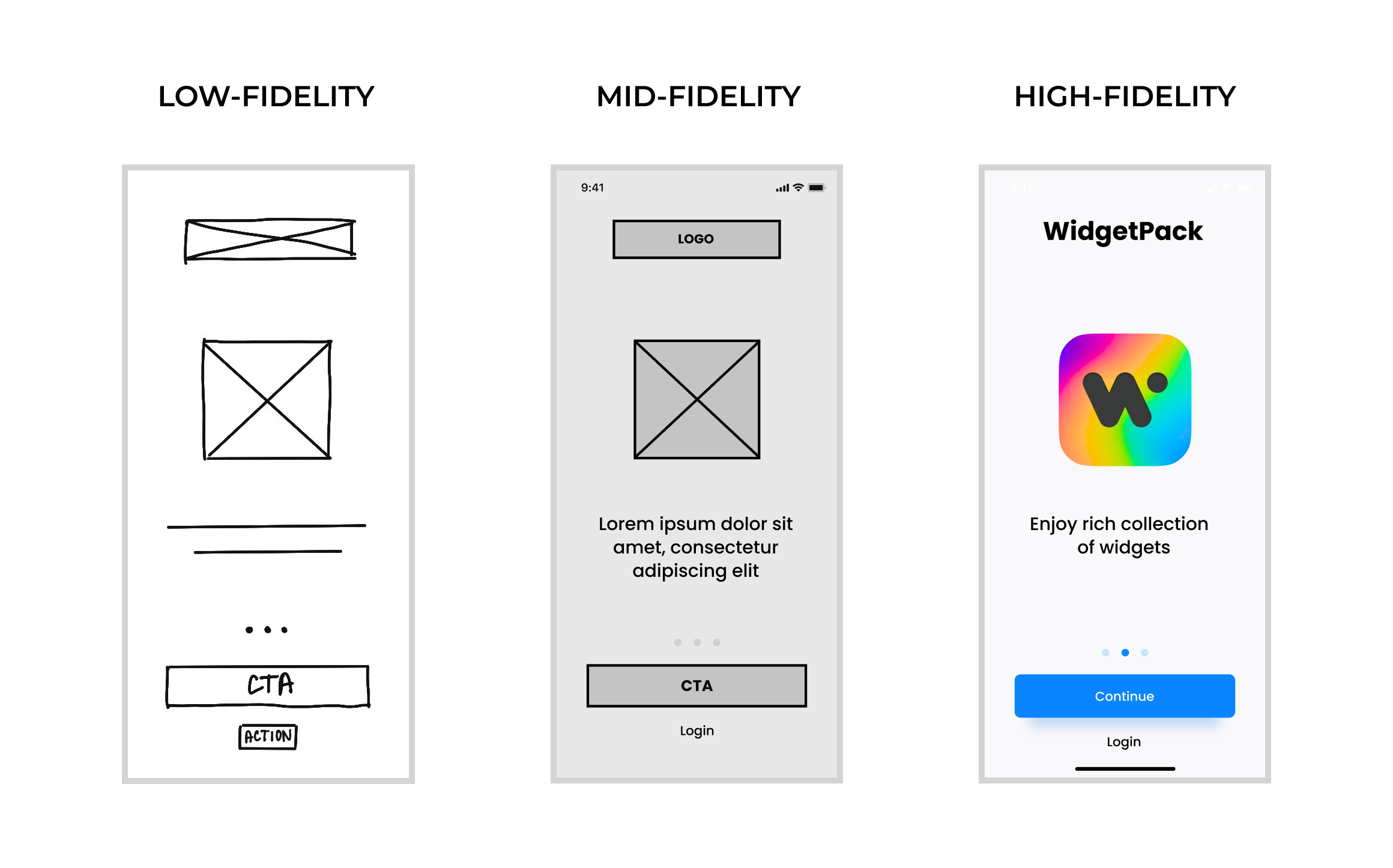Building an efficient web or mobile app comes well with a successful structure, known as wireframe. Creating a wireframe is a crucial step in the app development process as it helps users to navigate your app easily. And this article will walk you through every crucial aspect of wireframing and help you understand its significance for web and mobile app development.
What is Wireframing?
Wireframing is a crucial stage in the design process for websites and mobile applications. It involves creating a simplified visual guide that represents the skeletal framework of a digital product. These wireframes serve as blueprints, outlining the structure and functionality without focusing on design aesthetics like colors, fonts, or detailed graphics. Here’s a detailed explanation of wireframing:
Key Aspects of Wireframing
Structure and Layout
- Basic Elements: Wireframes use simple shapes like rectangles and lines to represent different elements (e.g., headers, footers, content areas, buttons).
- Grid and Alignment: They help in establishing a grid system and aligning elements consistently.
Content Hierarchy
- Information Placement: Wireframes prioritize content by indicating where the most important information should be placed.
- Visual Hierarchy: They establish a visual hierarchy that guides users through the page logically.
Functionality
- Interactive Elements: Wireframes indicate the placement of interactive elements such as buttons, links, forms, and navigation menus.
- User Flows: They outline user journeys by showing how different pages and interactions are connected.
User Experience (UX)
- Usability Focus: Wireframes focus on usability and user experience by mapping out user interactions and paths.
- Feedback and Testing: They provide a basis for early usability testing and feedback collection.
What are the Different Types of Wireframes?
There are mainly three types of wireframes, and the distinctive factors between them are the integrated features, amount of detailing, and complexity.

- Low-Fidelity Wireframes
- Simple and Quick: Basic sketches or digital outlines focusing on layout and structure without details.
- Tools: Can be created using pen and paper, whiteboards, or simple digital tools like Balsamiq.
High-Fidelity Wireframes
- Detailed and Polished: Include more details, such as specific UI elements and annotations, closer to the final design.
- Tools: Created using design tools like Sketch, Figma, or Adobe XD.
Interactive Prototypes
- Clickable Elements: High-fidelity wireframes with interactive elements that simulate user interactions.
- Tools: Developed using tools like InVision, Axure, or Figma to create interactive prototypes
Benefits of Wireframing
Clarifies Project Requirements
- Visual Communication: Provides a visual representation of the project’s requirements, ensuring all stakeholders understand the scope and functionality.
- Early Validation: Validates ideas and concepts early in the process.
Improves Collaboration
- Shared Understanding: Creates a common understanding among designers, developers, and stakeholders.
- Facilitates Feedback: Allows for early and continuous feedback, improving the design iteratively.
Saves Time and Resources
- Identifies Issues Early: Helps identify potential issues and usability problems before development begins.
- Reduces Rework: Minimizes rework during development by refining the design early.
Focuses on User Experience
- User-Centered Design: Emphasizes the user experience by outlining user flows and interactions.
- Usability Testing: Provides a basis for early usability testing and improvement.
Guides the Design Process
- Blueprint for Designers: Serves as a blueprint for visual designers, helping them understand where elements should be placed.
- Consistency: Ensures consistency in design and functionality across different devices and platforms.
Enhances Development Efficiency
- Clear Roadmap: Provides developers with a clear roadmap, detailing what needs to be built and how it should function.
- Efficient Development: Facilitates efficient and focused development by providing detailed specifications.
Creating apps is no less than creating art.
Learn non code app development with appbanao


Tools for Wireframing
- Sketch: Popular for creating high-fidelity wireframes and prototypes.
- Figma: Collaborative design tool that allows real-time collaboration and prototyping.
- Adobe XD: Comprehensive tool for wireframing, design, and prototyping.
- Balsamiq: Focuses on low-fidelity wireframes for quick and easy creation.
- InVision: Platform for creating interactive prototypes and wireframes.
What should a wireframe include?
A wireframe should include various elements to provide a clear and functional blueprint for a web or mobile app. Here are the key components that a comprehensive wireframe should include:
1. Layout and Structure
- Basic Page Layout: Overall structure of the page, including headers, footers, sidebars, and content areas.
- Grid System: Columns and rows to organize content and ensure alignment and consistency.
2. Content Placement
- Text Blocks: Representations of where headings, paragraphs, and other text content will be placed.
- Images and Media: Placeholders for images, videos, and other media elements.
- Buttons and Links: Locations of interactive elements like buttons and hyperlinks.
3. Navigation
- Menus: Main navigation menu, including dropdowns or expandable sections.
- Breadcrumbs: Secondary navigation elements showing the user’s path within the site or app.
- Pagination: Controls for navigating through multiple pages of content.
4. Interactive Elements
- Forms: Input fields, labels, and submit buttons for forms (e.g., contact forms, login forms).
- Call-to-Actions (CTAs): Buttons or links that prompt users to take specific actions (e.g., “Sign Up,” “Learn More”).
- Modals/Popups: Overlays or popups that appear upon certain interactions.
5. Functional Annotations
- Descriptions: Notes explaining the purpose and functionality of specific elements.
- Behavioral Indicators: Descriptions of interactive behaviors (e.g., “this button will expand the section below”).
- User Flow: Arrows or indicators showing the intended user journey through the app or site.
6. Placeholders for Dynamic Content
- Content Blocks: Areas designated for dynamic or changing content (e.g., blog posts, product listings).
- Carousels/Sliders: Indications of content that will cycle through multiple items.
7. Responsive Design Elements
- Breakpoints: Indications of how the layout will adjust for different screen sizes and orientations.
- Adaptive Components: Descriptions of how specific elements will change (e.g., navigation menu collapsing into a hamburger menu on mobile devices).
8. User Experience (UX) Considerations
- Accessibility Features: Notes on accessibility considerations, such as alt text for images or keyboard navigation.
- Loading States: Representations of how elements will appear during loading (e.g., skeleton screens).
- Error Handling: Indications of how errors will be displayed to users (e.g., form validation messages).
9. Branding and Style Guidance
- Logo Placement: Location of the logo and other brand elements.
- Font and Color Placeholders: Indications of where specific fonts and colors will be applied, even if the wireframe itself uses grayscale.
10. Annotations and Notes
- Functional Notes: Detailed explanations of functionality and interactions.
- Technical Notes: Information for developers about specific technical requirements or constraints.
- Client Feedback Sections: Areas for stakeholders to provide feedback and comments.

Significance of Wireframing in Web and Mobile App Development
Wireframing is a vital step in the web and mobile app development process, offering numerous benefits that contribute to the successful design and implementation of digital products. Here’s an overview of the significance of wireframing:
1. Clarifies Project Requirements
- Visual Blueprint: Wireframes provide a clear, visual representation of the app or website’s structure and functionality, helping stakeholders understand what is being built.
- Early Validation: They allow for the early validation of ideas and concepts, ensuring that the development team and stakeholders are aligned on the project’s goals and objectives.
2. Enhances Communication and Collaboration
- Common Language: Wireframes serve as a common language between designers, developers, and clients, reducing misunderstandings and miscommunications.
- Feedback Loop: They facilitate early and continuous feedback from stakeholders, which can be incorporated into the design before development begins.
3. Saves Time and Resources
- Identifies Issues Early: Wireframing helps identify potential issues and usability problems early in the design process, before significant time and resources are invested in development.
- Reduces Rework: By refining the layout and functionality in the wireframe stage, the amount of rework needed during development is minimized.
4. Focuses on User Experience (UX)
- User-Centered Design: Wireframes focus on the user experience by outlining user flows, interactions, and navigation paths, ensuring that the app or website is intuitive and user-friendly.
- Usability Testing: They provide a basis for early usability testing, allowing designers to test and improve the user experience before development.
5. Guides the Design Process
- Blueprint for Design: Wireframes act as a blueprint for the visual design, helping designers understand where elements like images, buttons, and content should be placed.
- Content Hierarchy: They help establish a clear content hierarchy, ensuring that the most important information is prioritized and easily accessible to users.
6. Facilitates Efficient Development
- Clear Roadmap: Wireframes provide developers with a clear roadmap, detailing what needs to be built and how it should function, which leads to more efficient and focused development.
- Component Specification: They help in specifying UI components and their interactions, making it easier for developers to implement the design accurately.
7. Supports Responsive Design
- Multiple Layouts: Wireframes can be created for different screen sizes and devices, ensuring that the app or website will be responsive and work well across various platforms.
- Consistency: They ensure consistency in design and functionality across different devices and screen sizes.
8. Enhances Stakeholder Engagement
- Interactive Prototypes: Advanced wireframes can be turned into interactive prototypes, providing stakeholders with a tangible representation of the app or website, which can enhance engagement and buy-in.
- Informed Decision-Making: Stakeholders can make informed decisions about design and functionality based on a clear understanding of the wireframe.
9. Ensures Accessibility and Inclusivity
- Accessibility Considerations: Wireframes can include notes on accessibility features, ensuring that the design meets the needs of users with disabilities.
- Inclusive Design: They help designers think about inclusivity early in the process, leading to a more universally usable product.
10. Optimizes Project Management
- Task Breakdown: Wireframes help break down the project into manageable tasks, making it easier to allocate resources and set realistic timelines.
- Progress Tracking: They provide a reference point for tracking progress and ensuring that the project stays on track.
.
